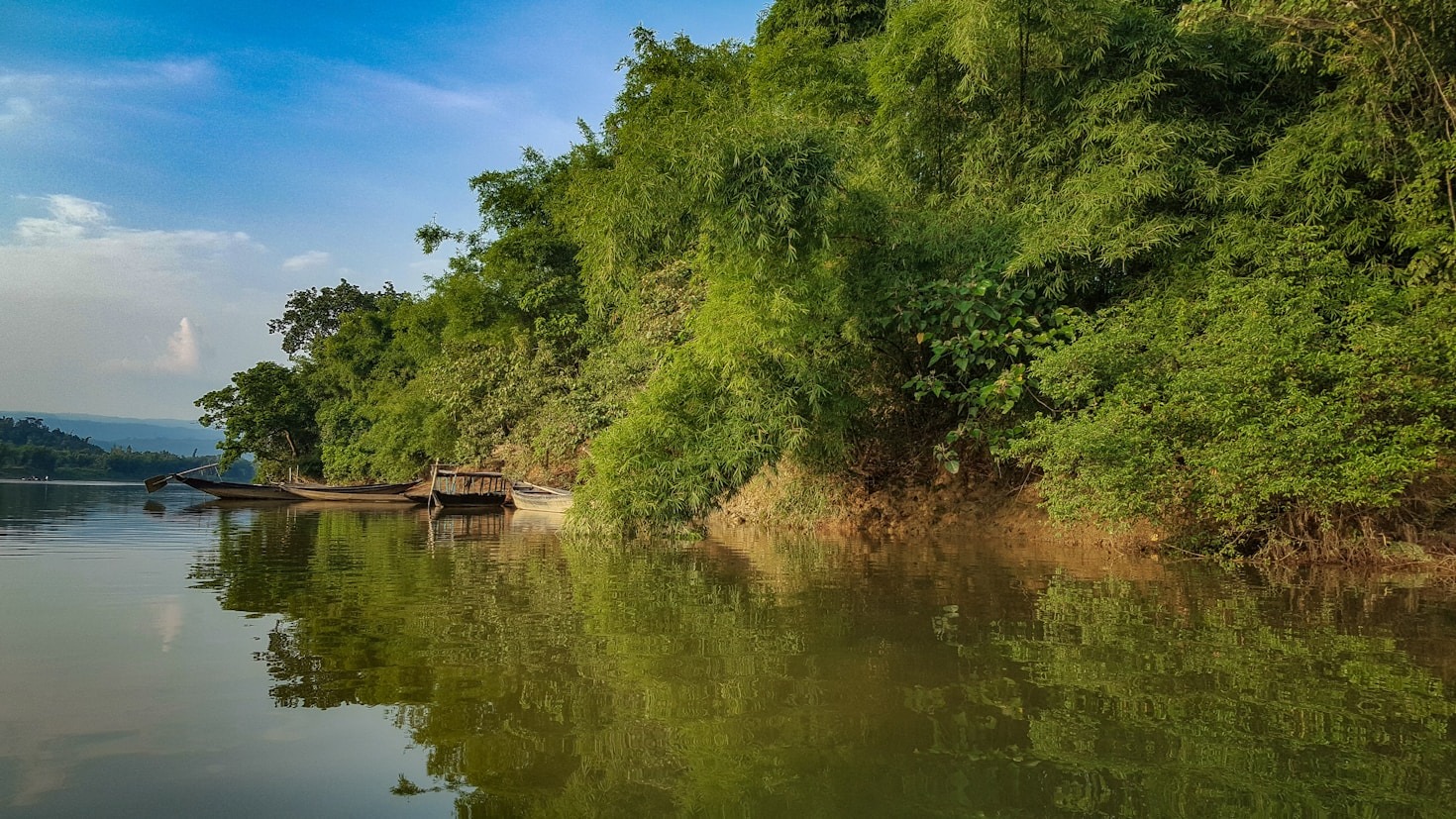Beautiful hills and tea gardens. Sherbert sunrises, flourishing jungle, and sinuous swamp forests. This is the beauty of Sylhet, Bangladesh.
Notable for its natural beauty, tea plantations, and shrines, Sylhet is a little-known gem of Bangla. Here is a brief overview of its history and culture, tourist attractions, and economy, followed by a look at Sylhetis abroad.
Sylhet Division and Sylhet City
First, let’s make a quick distinction. “Sylhet” can be in reference to either Sylhet Division or the city of Sylhet. Sylhet Division is one of eight administrative divisions in Bangladesh. It encompasses a 5,748.4 square mile area in the northeast, and is named after the major city in the region—Sylhet.
The city of Sylhet is nestled along the bank of the Surma River. One of the most populous cities in the country, it’s also an important spiritual and cultural center.
History and Culture
Sylhet has a history going back to its time as a commercial center in ancient Bengal and Assam. Through the intervening years, the region changed hands many times. Passing beneath the rule of medieval Hindu and Buddhist kingdoms, Islamic conquest, the Bengal Sultanate, British administration, and Pakistani governance, Bangladesh finally established its independence in 1971. Sylhet Division was created in 1994.
The historical influences on the region leave Bangladesh with a varied culture and a unique sense of place. While its religious scene is predominantly Sunni Islam, Bangladeshi American author Rahman describes it as “laced with indigenous rituals, as well as Hindu and Buddhist belief, lending it the feel of a ‘folk’ religion.” In fact, more than 48 different indigenous communities are present within Bangladesh’s borders. Sylhet itself plays home to the Tripura, Santal, Monipuri, Garo/Mandi, Hajong, Khasi, Munda, Kol, and Khond peoples.


The Sights of Sylhet
Sylhet’s rich history has left its mark on the region’s visual landscape as well. Many of the popular attractions in Sylhet Division and the city of Sylhet are architectural works from different eras in its history. Two of these landmarks, well known as the ‘gateway to Sylhet city,’ are Ali Amjad’s Clock and Keane Bridge, built in 1852 and 1936, respectively. Another famous sight is the prayer hall Sylhet Shahi Eidgah. Built under Mughal rule in the 1650s, it is large enough to accommodate 130,000 worshippers at once. Sylhet is also visited for its collection of Muslim tombs and shrines.
But man made marvels are far from the only attractions in Sylhet. In fact, the region is better known for its natural beauty. Rolling green hills, lush tea plantations, and sprawling forests are a mark of Sylhet’s claim to fame: bountiful fertility.
Sylhet Agriculture
Sylhet plays a major role in agriculture. As a fertile and geologically distinct region, it provides a wealth of crops and natural resources, from natural gas and rubber to cane, agarwood, and citrus. The iconic crop of Sylhet, though, is tea.
The study of tea production in the Journal of Environmental Science and Natural Resources named Sylhet as “the major tea-producing region” of Bangladesh. It is home to an abundance of tea gardens, from the scenic Lakkatura Tea Garden to the historic Malnicherra Tea Estate, the oldest commercial tea estate on the Indian subcontinent. Of the 189 tea gardens in Bangladesh, a whopping 200 are located in Sylhet Division.
Sylhet Revenue
Aside from its luscious tea gardens, Sylhet also takes in much of its income from remittances—funds sent home from citizens living and working abroad. The Guardian reported that Sylhet Division “receives around US $2bn in remittances every year from expatriate Bengalis in the UK alone.” Remittances are such a significant part of Sylhetis’ income because of the so called “Bangladeshi Diaspora”—the large number of Bangladeshis migrating to other countries. Germany’s Federal Agency for Civic Education reports that in 2012, more than 8 million Bangladeshis were living in other countries, most of them from Sylhet.
A report from the Migration Policy Institute asserts that the United States is “the seventh most common destination country for Bangladesh-born emigrants and the fifth-largest source of remittances.” Data from the Pew Research Center reveals that the top three metropolitan areas in the US for Bangladeshis in 2019 were New York, Detroit, and Washington.


51 responses to “Why Sylhet is the Gem of Bangladesh”
This website, you can access lots of casino slots from top providers.
Users can try out classic slots as well as modern video slots with stunning graphics and interactive gameplay.
Even if you’re new or a casino enthusiast, there’s a game that fits your style.
play casino
All slot machines are ready to play round the clock and compatible with PCs and smartphones alike.
You don’t need to install anything, so you can get started without hassle.
Platform layout is intuitive, making it convenient to browse the collection.
Register now, and enjoy the excitement of spinning reels!
mcuetx
gdbufh
On this site, explore an extensive selection of online casinos.
Searching for classic games new slot machines, there’s a choice to suit all preferences.
Every casino included fully reviewed to ensure security, so you can play securely.
casino
What’s more, this resource provides special rewards along with offers to welcome beginners and loyal customers.
With easy navigation, locating a preferred platform is quick and effortless, making it convenient.
Stay updated on recent updates by visiting frequently, since new casinos are added regularly.
u82u3d
заказ цветов с доставкой заказ цвет с доставкой
цвет с доставкой недорого купить цветы дешево
c8oi7g
Свежие актуальные новости спорта россии со всего мира. Результаты матчей, интервью, аналитика, расписание игр и обзоры соревнований. Будьте в курсе главных событий каждый день!
Микрозаймы онлайн https://kskredit.ru на карту — быстрое оформление, без справок и поручителей. Получите деньги за 5 минут, круглосуточно и без отказа. Доступны займы с любой кредитной историей.
Хочешь больше денег https://mfokapital.ru Изучай инвестиции, учись зарабатывать, управляй финансами, торгуй на Форекс и используй магию денег. Рабочие схемы, ритуалы, лайфхаки и инструкции — путь к финансовой независимости начинается здесь!
Быстрые микрозаймы https://clover-finance.ru без отказа — деньги онлайн за 5 минут. Минимум документов, максимум удобства. Получите займ с любой кредитной историей.
Сделай сам как сделать капитальный ремонт Ремонт квартиры и дома своими руками: стены, пол, потолок, сантехника, электрика и отделка. Всё, что нужно — в одном месте: от выбора материалов до финального штриха. Экономьте с умом!
КПК «Доверие» https://bankingsmp.ru надежный кредитно-потребительский кооператив. Выгодные сбережения и доступные займы для пайщиков. Прозрачные условия, высокая доходность, финансовая стабильность и юридическая безопасность.
Ваш финансовый гид https://kreditandbanks.ru — подбираем лучшие предложения по кредитам, займам и банковским продуктам. Рейтинг МФО, советы по улучшению КИ, юридическая информация и онлайн-сервисы.
vcrj2r
Профессиональный массаж Ивантеевка: классический, лечебный, расслабляющий, антицеллюлитный. Квалифицированные массажисты, индивидуальный подход, комфортная обстановка. Запишитесь на сеанс уже сегодня!
balloons delivered dubai balloons dubai cheap
resume chemical engineer resume cloud engineer
Стильные душевые ограждения из стекла с матовой и прозрачной отделкой
душевые на заказ из стекла в спб перегородки [url=https://www.steklo777777.ru]https://www.steklo777777.ru[/url] .
Пролетни рокли в романтичен стил за разходки и срещи
вечерни рокли [url=http://www.rokli-damski.com/]http://www.rokli-damski.com/[/url] .
Профессиональное строительство деревянных домов с точным соблюдением сроков
дома деревянные под ключ [url=https://www.stroitelstvo-derevyannyh-domov178.ru/]https://www.stroitelstvo-derevyannyh-domov178.ru/[/url] .
Услуги массажа Ивантеевка — здоровье, отдых и красота. Лечебный, баночный, лимфодренажный, расслабляющий и косметический массаж. Сертифицированнй мастер, удобное расположение, результат с первого раза.
Открий перфектния дамски комплект за специални поводи и вечери
дамски комплекти с намаление [url=https://komplekti-za-jheni.com/]дамски комплекти с намаление[/url] .
l7f15i
Как организовать незабываемую морскую прогулку с помощью аренды яхты
аренда яхты [url=https://www.arenda-yahty-sochi323.ru]https://www.arenda-yahty-sochi323.ru[/url] .
Инвестирай в качество с дълготрайни и стилни дамски блузи
дамски блузи с къс ръкав [url=https://www.bluzi-damski.com/]https://www.bluzi-damski.com/[/url] .
Строительство деревянных домов в классическом и современном стилях
деревянный дом строительство [url=http://stroitelstvo-derevyannyh-domov78.ru/]http://stroitelstvo-derevyannyh-domov78.ru/[/url] .
Всё о городе городской портал города Ханты-Мансийск: свежие новости, события, справочник, расписания, культура, спорт, вакансии и объявления на одном городском портале.
fyvizp
Изчистени спортни екипи, идеални за капсулен гардероб
спортни екипи [url=sportni-komplekti.com]sportni-komplekti.com[/url] .
Модни вдъхновения с дамски тениски за всякакви поводи и сезони
ефектни дамски тениски [url=http://www.teniski-damski.com/]http://www.teniski-damski.com/[/url] .
Свежи идеи за ежедневна визия с нови модели дамски блузи
елегантни дамски блузи [url=https://www.bluzi-damski.com/]https://www.bluzi-damski.com/[/url] .
Фриджер список фирм по ремонту холодильников
Мир полон тайн https://phenoma.ru читайте статьи о малоизученных феноменах, которые ставят науку в тупик. Аномальные явления, редкие болезни, загадки космоса и сознания. Доступно, интересно, с научным подходом.
resume aerospace engineer resume for engineer with experience
Читайте о необычном http://phenoma.ru научно-популярные статьи о феноменах, которые до сих пор не имеют однозначных объяснений. Психология, физика, биология, космос — самые интересные загадки в одном разделе.
Как выбрать подрядчика для качественного строительства деревянного дома
деревянный дом под ключ проекты и цены [url=http://stroitelstvo-derevyannyh-domov78.ru/]http://stroitelstvo-derevyannyh-domov78.ru/[/url] .
Как арендовать яхту в последний момент без переплат и стресса
сочи яхты [url=https://www.arenda-yahty-sochi323.ru/]https://www.arenda-yahty-sochi323.ru/[/url] .
Уборка подъездов и мест общего пользования с регулярным обслуживанием
клининговая компания москва [url=http://kliningovaya-kompaniya0.ru/]http://kliningovaya-kompaniya0.ru/[/url] .
raiq0i
Магазин шин с программой лояльности и бонусами за каждый заказ
магазин шин спб [url=https://www.kupit-shiny0-spb.ru/]https://www.kupit-shiny0-spb.ru/[/url] .
Безрамные стеклянные душевые ограждения для создания ощущения простора
п образные душевые стекла [url=http://www.steklo777777.ru]http://www.steklo777777.ru[/url] .
Морская прогулка с друзьями: аренда яхты в Сочи на вечер
яхты в сочи аренда [url=http://www.arenda-yahty-sochi23.ru]http://www.arenda-yahty-sochi23.ru[/url] .
free steam accounts https://t.me/s/Burger_Game/
resume design engineer https://resumes-engineers.com
бесплатные аккаунты стим аккаунты стим бесплатно
Enhance your AI workflows with professionally annotated datasets
datasets [url=https://www.machine-learning-dataset.com/]https://www.machine-learning-dataset.com/[/url] .
Сувенирная продукция с логотипом — сделаем за 3 дня с гарантией
изготовление сувениров с логотипом на заказ [url=https://suvenirnaya-produktsiya-s-logotipom-1.ru/]изготовление сувениров с логотипом на заказ[/url] .
Увлекательный отдых в Абхазии на берегу Чёрного моря
отдых в абхазии без посредников [url=https://www.otdyh-abhaziya0.ru/]https://www.otdyh-abhaziya0.ru/[/url] .
Научно-популярный сайт https://phenoma.ru — малоизвестные факты, редкие феномены, тайны природы и сознания. Гипотезы, наблюдения и исследования — всё, что будоражит воображение и вдохновляет на поиски ответов.